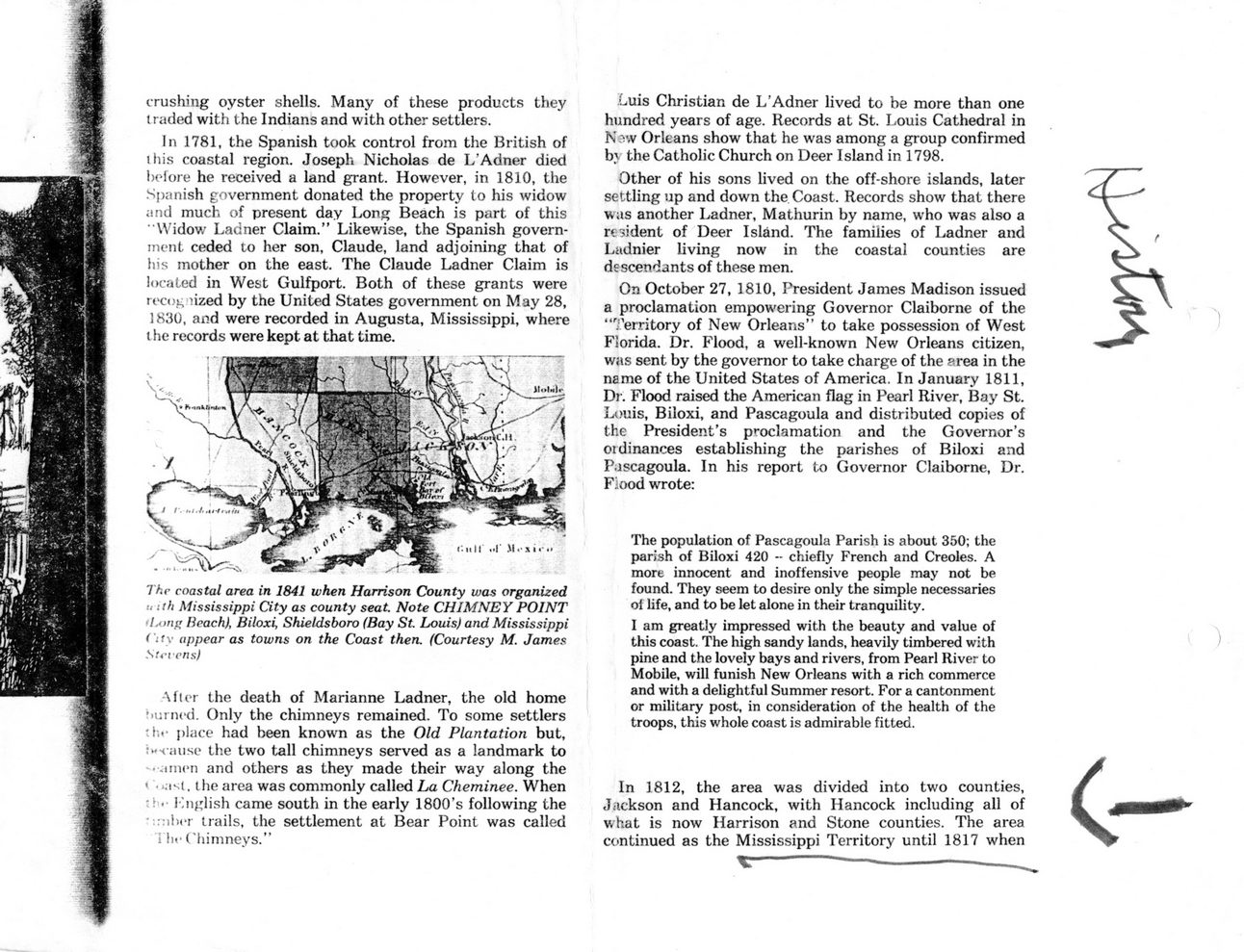This text was obtained via automated optical character recognition.
It has not been edited and may therefore contain several errors.
crushing oyster shells. Many of these products they traded with the Indians and with other settlers. In 1781, the Spanish took control from the British of i his coastal region. Joseph Nicholas de L?Adner died before he received a land grant. However, in 1810, the Spanish government donated the property to his widow and much of present day Long Beach is part of this Widow Ladner Claim.? Likewise, the Spanish government ceded to her son, Claude, land adjoining that of his mother on the east. The Claude Ladner Claim is located in West Gulfport. Both of these grants were recofc lized by the United States government on May 28, 1830, and were recorded in Augusta, Mississippi, where t he records were kept at that time. The coastal area in 1841 when Harrison County was organized u i th Mississippi City as county seat. Note CHIMNEY POINT ilAinfr Beach), Biloxi, Shieldsboro (Bay St. Louis) and Mississippi City appear as towns on the Coast then. (Courtesy M. James Stftcns) Nfler the death of Marianne Ladner, the old home burned. Only the chimneys remained. To some settlers place had been known as the Old Plantation but, !?fiiuse the two tall chimneys served as a landmark to -??.mien and others as they made their way along the < the area was commonly called La Cheminee. When Knglish came south in the early 1800?s following the * ::?ibiT trails, the settlement at Bear Point was called i he Chimneys.? Luis Christian de L?Adner lived to be more than one hundred years of age. Records at St. Louis Cathedral in New Orleans show that he was among a group confirmed b\ the Catholic Church on Deer Island in 1798. Other of his sons lived on the off-shore islands, later settling up and down the Coast. Records show that there w as another Ladner, Mathurin by name, who was also a resident of Deer Island. The families of Ladner and Ladnier living now in the coastal counties are descendants of these men. On October 27, 1810, President James Madison issued a proclamation empowering Governor Claiborne of the ?Territory of New Orleans? to take possession of West Florida. Dr. Flood, a well-known New Orleans citizen, was sent by the governor to take charge of the ?rea in the name of the United States of America. In January 1811, Dr. Flood raised the American flag in Pearl River, Bay St. Louis, Biloxi, and Pascagoula and distributed copies of the President?s proclamation and the Governor?s ordinances establishing the parishes of Biloxi and P.iscagoula. In his report to Governor Claiborne, Dr. Fiood wrote: The population of Pascagoula Parish is about 350; the parish of Biloxi 420 -- chiefly French and Creoles. A more innocent and inoffensive people may not be found. They seem to desire only the simple necessaries of life, and to be let alone in their tranquility. I am greatly impressed with the beauty and value of this coast. The high sandy lands, heavily timbered with pine and the lovely bays and rivers, from Pearl River to Mobile, will funish New Orleans with a rich commerce and with a delightful Summer resort. For a cantonment or military post, in consideration of the health of the troops, this whole coast is admirable fitted. In 1812, the area was divided into two counties, Jackson and Hancock, with Hancock including all of what is now Harrison and Stone counties. The area continued as the Mississippi Territory until 1817 when x:-------------------------------------------?

Ladner 一document-18